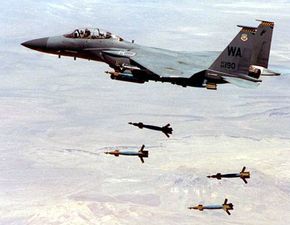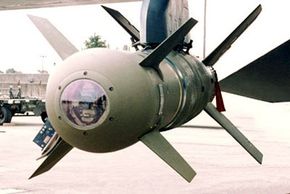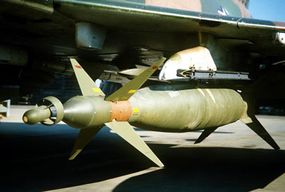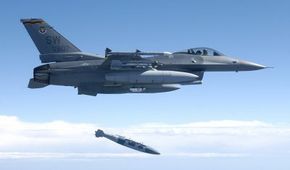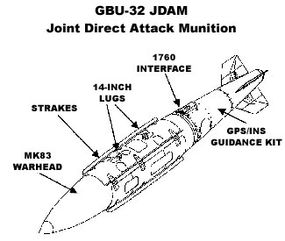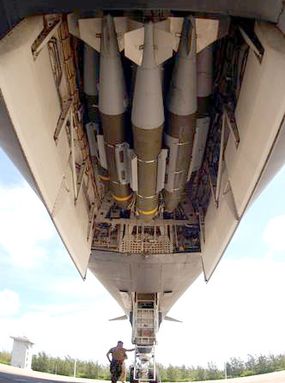The basic concept of a bomb could hardly be simpler. A conventional bomb consists of some explosive material packed into a sturdy case with a fuze mechanism (yes, that's fuze, not fuse). The fuze mechanism has a triggering device -- typically a time-delay system, an impact sensor or a target-proximity sensor -- which sets the bomb off. When the trigger goes off, the fuze ignites the explosive material, resulting in an explosion. The extreme pressure and flying debris of the explosion destroys surrounding structures (see How Grenades Work for information on explosives and fuzes).
Smart Bomb Image Gallery
Advertisement
A "dumb bomb" is a bomb with only these elements, dropped from an airplane (such as the B-2 bomber). The bomb is considered "dumb" because it simply falls to the ground without actively steering itself. Needless to say, it's some feat hitting a target precisely with this type of weapon. A bomber might have to drop dozens, or even hundreds of dumb bombs to take out a target effectively.
"Smart bombs," by contrast, control their fall precisely in order to hit a designated target dead on. In this article, we'll find out how the major types of smart bomb accomplish this.
Smart Bomb Basics
A smart bomb is essentially an ordinary dumb bomb with a few major modifications. In addition to the usual fuze and explosive material, it has:
- an electronic sensor system
- a built-in control system (an onboard computer)
- a set of adjustable flight fins
- a battery
When a plane drops a smart bomb, the bomb becomes a particularly heavy glider. It doesn't have any propulsion system of its own, like a missile does, but it does have forward velocity (by virtue of being dropped from a speeding plane). It also has flight fins that generate lift and stabilize its flight path.

The control system and adjustable fins give the bomb a way to steer itself as it glides through the air. While the bomb is "in flight," the sensor system and control system track the designated target on the ground. The sensor system feeds the control system the relative position of the target, and the control system processes this information and figures out how the bomb should turn to steer toward the target.
To actually turn the bomb, the control system sends a message to actuators that adjust the flight fins. These fins work the same basic way as the various flaps on an airplane. By tilting the fins in a particular direction, the control system increases the drag acting on that side of the bomb. As a result, the bomb turns in that direction. (See How Airplanes Work for more information).
This adjustment process continues until the smart bomb reaches its target, and the fuze mechanism sets off the explosive. Smart bombs generally have proximity fuzes, which set off the explosive just before the bomb reaches the target, or impact fuzes, which set off the explosive when the bomb actually hits something.
The main difference between the different types of smart bomb is how the sensor system actually "sees" the target in the first place. We'll look at how smart bombs have done this in the past in the next section.
